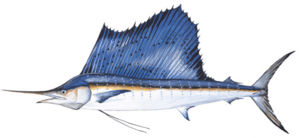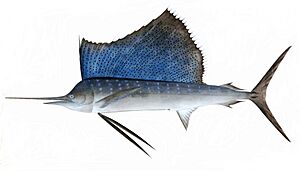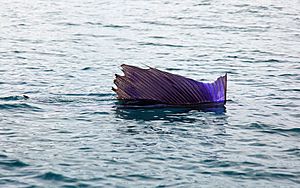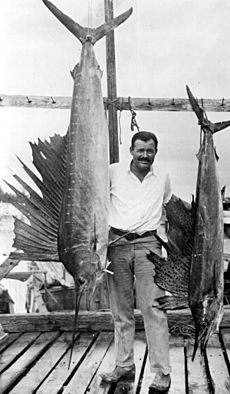Sailfish facts for kids
Quick facts for kids Sailfish |
|
|---|---|
 |
|
| Atlantic sailfish | |
 |
|
| Indo-Pacific sailfish | |
| Conservation status | |
| Scientific classification |
|
| Kingdom: | Animalia |
| Phylum: | Chordata |
| Class: | Actinopterygii |
| Order: | Istiophoriformes |
| Family: | Istiophoridae |
| Genus: | Istiophorus Lacépède, 1801 |
| Type species | |
| Scomber gladius (G. Shaw, 1792)
|
|
| Species | |
|
|
| Synonyms | |
|
|

The sailfish is a type of marine fish found in the genus Istiophorus. These amazing fish are part of the family Istiophoridae, which also includes marlins. Sailfish are usually blue to gray. They have a very large dorsal fin that looks like a sail, running almost the whole length of their back.
Another cool feature is their long, pointy snout, called a bill. This bill is similar to those of other marlins and the swordfish. Together, these fish are known as billfish. Sailfish live in the colder parts of all Earth's oceans. They are known for being one of the fastest animals in the sea!
Contents
Sailfish Species
Scientists have different ideas about how many types of sailfish there are. Some believe there is only one species, while others think there are two. Studies looking at their DNA and body shapes haven't found many differences between the two supposed types.
Most experts now agree there's just one species, Istiophorus platypterus. This species lives in warm oceans all over the world. However, a website called FishBase still lists two species:
- Atlantic sailfish (I. albicans)
- Indo-Pacific sailfish (I. platypterus)
What Do Sailfish Look Like?
Many scientists think sailfish are the fastest fish in the ocean. They grow very quickly, reaching about 1.2 to 1.5 meters (4 to 5 feet) long in just one year! They eat smaller ocean fish and squid near the surface or in the middle depths of the water.
Older studies suggested sailfish could swim as fast as 35 meters per second (126 km/h or 78 mph). But newer research from 2015 and 2016 shows they don't go faster than 10 to 15 meters per second (36 to 54 km/h or 22 to 34 mph). When chasing prey, they can reach quick bursts of 7 meters per second (25 km/h or 16 mph).
Sailfish usually don't grow longer than 3 meters (10 feet) and rarely weigh more than 90 kilograms (200 pounds).
Some reports say that sailfish can change their colors. They might do this to confuse their prey, show how they are feeling, or talk to other sailfish. Sailfish have also been known to attack humans if they feel threatened.
How Sailfish Hunt
Sailfish use their long bills to hit schools of fish. They might tap them with a short movement or slash at them with a wider, horizontal swing.
When swimming normally, a sailfish keeps its large sail fin folded down. It only raises the sail when it's attacking prey. Raising the sail helps to keep the sailfish's head steady. This makes its bill harder for prey fish to see. This way, the sailfish can get its bill very close to or even into a group of fish without them noticing before it strikes.
Sailfish usually attack one at a time. The small teeth on their bills injure the prey fish, removing scales and skin. Often, about two fish are hurt during an attack, but only about 24% of attacks actually catch a fish. This means that more and more injured fish gather in a school that is being attacked.
Since injured fish are easier to catch, sailfish benefit from other sailfish attacking the same school. This is a type of "proto-cooperation." It means they help each other without needing to plan their attacks together. A study showed that groups of up to 70 sailfish could benefit this way.
When a sailfish attacks, it usually swings its bill either to the left or to the right. Scientists can identify individual sailfish by the shape of their dorsal fins. They found that individual sailfish often prefer to hit to one side. Sailfish that strongly prefer one side are better at catching prey.
This "side-preference" helps them hunt better. However, if a sailfish always hits to the same side, its prey might learn to predict its moves. But because there are about equal numbers of left- and right-hitting sailfish in a group, it's hard for prey fish to guess where the next attack will come from. This means group hunting helps individual sailfish specialize without becoming too predictable to their prey.
The injuries sailfish cause to their prey seem to slow them down. Injured fish are more often found at the back of a school. When a sailfish approaches a school of sardines, the sardines usually turn and swim away. Sailfish often attack from behind, putting the slower, injured fish at the back of the school at risk.
Sailfish Habitat
Sailfish live in the open ocean, but they often come close to coasts, islands, and coral reefs. They are found in the tropical and temperate waters of the Pacific and Indian oceans.
In some areas, sailfish depend on coral reefs for food and for breeding. For example, in the Persian Gulf, when coral reefs disappeared, the sailfish also disappeared from that area.
Predators
When sailfish are very young, they are eaten by other fish that mostly eat tiny sea creatures called plankton. As sailfish grow bigger, their predators also get bigger. Adult sailfish are not eaten by many animals, except for large ocean sharks and orcas (killer whales).
Timeline

See also
 In Spanish: Pez vela para niños
In Spanish: Pez vela para niños



